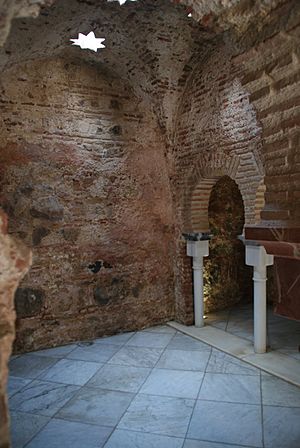Arab Baths (Ceuta) facts for kids
Quick facts for kids Arab Baths |
|
|---|---|
| Native name Spanish: Baños Árabes |
|

Inner chamber of the Arab Baths in the plaza de la Paz, Ceuta
|
|
| Location | Ceuta, Spain |
| Official name: Baño árabe de la plaza de la Paz | |
| Type | Non-movable |
| Criteria | Monument |
| Designated | 2007 |
| Reference no. | RI-51-0012081 |
| Lua error in Module:Location_map at line 420: attempt to index field 'wikibase' (a nil value). | |
The Arab Baths in Ceuta, Spain, are old public baths from the Middle Ages. They are found on the edge of the old city, known as the Medina quarter. People think this area has been used since the 11th century. When archaeologists explored the baths in 2000 and 2004, they found that the baths had rooms for changing clothes and toilets. There was also a cold bath and a hot bath. This style of bathing was similar to what the Romans used. There might have been other rooms too.
Contents
History of the Arab Baths
When Were the Baths Built?
The earliest signs of people living in this area of Ceuta are from the 11th century. Back then, there was a street and homes. The baths themselves were built later, during the 12th and 13th centuries.
How Were the Baths Designed?
Archaeologists have learned a lot about how the baths were set up. They had a room where people could change their clothes and use the toilet. After that, there was a cold bath. Then, people would move to a hot bath. This way of bathing was very similar to how the Romans designed their public baths.
Some parts of the original ceilings, which were shaped like arches, are still there. It seems there were other rooms too, but they have been lost over time. The building was made bigger in the 14th century. However, by the 15th century, stones from the baths were being used for other building projects. People believe the arched roofs were once covered in beautiful marble. By the 17th century, the baths were no longer in use.
Discovery and Recognition
The Arab Baths were found by accident during building work on a street. Since then, archaeologists have carefully dug them up in 2000 and 2004. Today, you can visit these ancient remains. They look quite old-fashioned next to the modern main road in Ceuta. In 2007, the baths were officially recognized as an important national monument in Spain.
See also
 In Spanish: Baño árabe de la plaza de la Paz (Ceuta) para niños
In Spanish: Baño árabe de la plaza de la Paz (Ceuta) para niños

